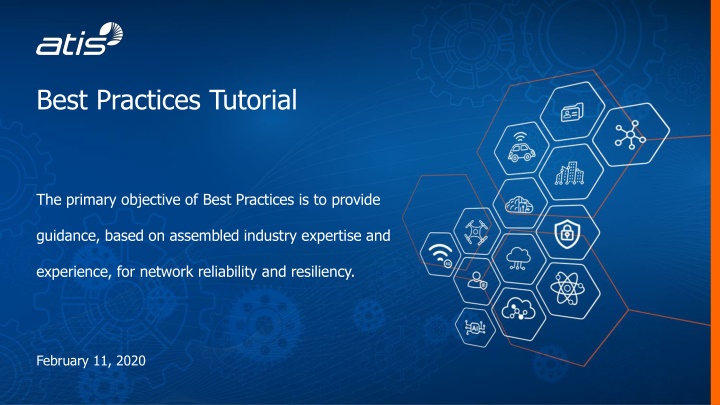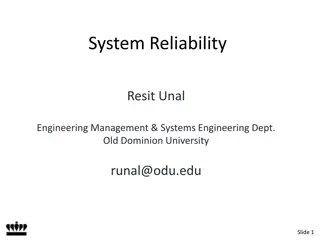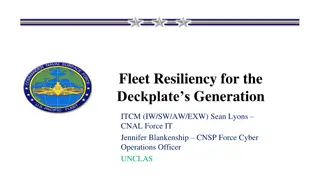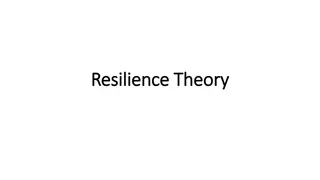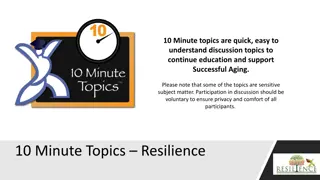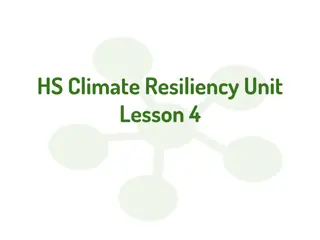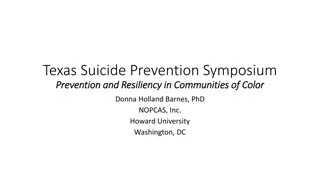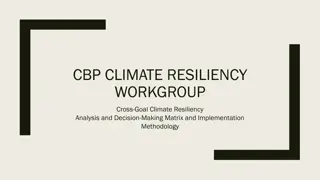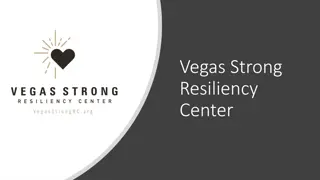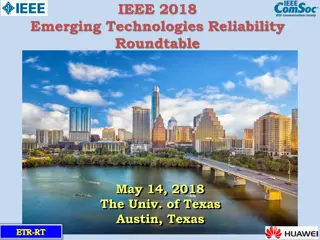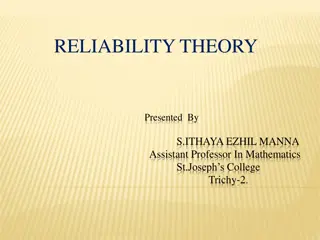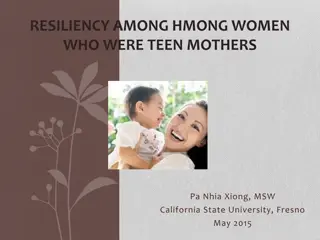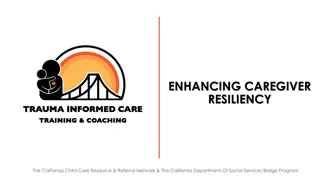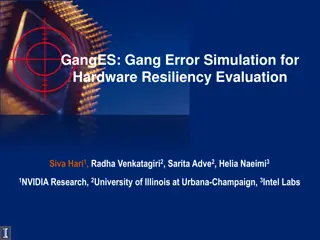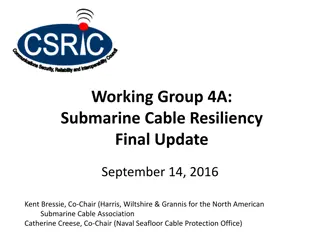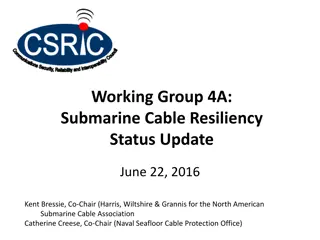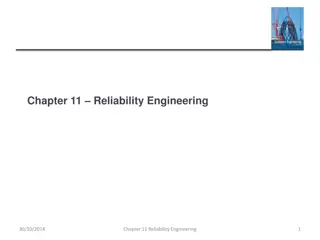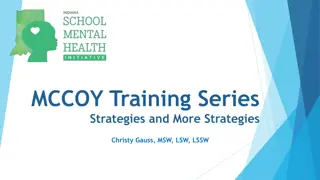Best Practices Tutorial - Network Reliability and Resiliency
Guidelines for network reliability and resiliency focused on proven practices, addressing various problem classes, following a specific format, and not endorsing commercial products or services. Best practices are developed through expert consensus and stakeholder input, with clear guidelines on implementation and applicability. Each practice is carefully curated to ensure reliability and resiliency in diverse industry settings.
Download Presentation

Please find below an Image/Link to download the presentation.
The content on the website is provided AS IS for your information and personal use only. It may not be sold, licensed, or shared on other websites without obtaining consent from the author.If you encounter any issues during the download, it is possible that the publisher has removed the file from their server.
You are allowed to download the files provided on this website for personal or commercial use, subject to the condition that they are used lawfully. All files are the property of their respective owners.
The content on the website is provided AS IS for your information and personal use only. It may not be sold, licensed, or shared on other websites without obtaining consent from the author.
E N D
Presentation Transcript
Best Practices Tutorial The primary objective of Best Practices is to provide guidance, based on assembled industry expertise and experience, for network reliability and resiliency. February 11, 2020
Best Practices Guidelines 1. Proven through actual implementation more than just a good idea 2. Address classes of problems (rather than one-time issues) 3. A single concept should be captured in each practice (one thought, one practice) 4. Should not endorse specific commercial documents, products, or services 5. Developed through rigorous deliberation and expert consensus 6. Confirmed by a broad set of stakeholders 7. Should not be assumed to be applicable in all situations or to all industry types 8. Does not imply mandatory implementation 2
Best Practice Format All Best Practices should follow the format of: __________________ should ___________________ 1st blank Who : consists of the implementer (i.e., Network Operators, Service Providers, Equipment Suppliers, Property Managers, Public Safety, Government) 2nd blank What : consists of the Best Practice. The Best Practice may include the use of a modifier after the word should (e.g., Network Operators should consider, etc.) 3
Best Practice Example Second Blank- WHAT First Blank- WHO Modifier Network Operators, Service Providers and Equipment Suppliers should ensure that all network infrastructure equipment meets the minimum requirements of ANSI T1.319 (fire resistance). Supporting information, found in Reference section. In order to prevent fire. GR63 NEBS Requirements: Physical Protection, Telcordia at http://telecom- info.telcordia.com/site-cgi/ido/docs2.pl?ID=170086171&page=home; ATIS-0600319.2008 Equipment Assemblies Fire Propagation Risk Assessment Criteria at http://www.atis.org/docstore Should be located in the reference section. Does not belong in actual BP. 4
Best Practice Numbering Format For existing NRIC/CSRIC Best Practices: Each Best Practice has a unique numbering format: XX - YY - Z### XX = the current, or most recent, NRIC/CSRIC Council (e.g., 8 in 2009-2010) YY = the Council in which the Best Practice was last edited Z = 0 and 4 for Network Reliability and Interoperability 1 for Disaster Recovery and Mutual Aid 3 for Public Safety 5 for Physical Security 8 and 9 for Cyber Security ### = any digits, where every Best Practice has a unique Z### CS XX-YY-ZZZZ XX-YY-ZZZZ NRIC III 1 1 NRIC IV 2 2 NRIC V 3 3 NRIC VI 4 4 NRIC VII 5 5 NRIC VIII 6 6 CSRIC I 7 7 CSRIC II 8 8 CSRIC III 9 9 CSRIC IV 10 10 CSRIC V 11 11 CSRIC VI 12 12 CSRIC VII 13 13 CSRIC VIII 14 14 CSRIC IX 15 15 CSRIC X 16 16 CSRIC XI 17 17 5
Other Considerations For each new Best Practice (BP) identify: Recommended Category Public Safety & Disaster Standard Industry Role(s) Network Type(s) Applicable Keyword(s) Reference/Comments Recommended Category (for number assignment purposes) Network Reliability and Interoperability Disaster Recovery and Mutual Aid Public Safety Physical Security Cyber Security 6
Best Practice Network Types Cable An entity that provides communications through direct connectivity, predominantly by coaxial cable or optical fiber, between the serving central office and end user location(s). Internet/Data An entity that provides internet and/or data communications through direct connectivity, predominantly by wire, coaxial cable, or optical fiber, between facilities-based and non-facilities-based serving networks and end user location(s). Satellite An entity that provides communications through satellite connectivity. Wireless An entity that provides communications through radio spectrum allocation and/or CMRS networks between the mobile switching center(s) and end users. Wireline An entity that provides communications through direct connectivity, predominantly by wire or optical fiber, between the serving central office and end user location(s). 7
Best Practices Industry Roles Network Operators An entity responsible for the operation, administration, maintenance, and provisioning (OAM&P) of communications networks. Service Providers An entity responsible for providing communications services for consumer and business customers. Equipment Suppliers An organization whose business is to supply network operators and service providers with equipment or software required to render reliable network service. Property Managers An entity responsible for the operation of a physical location that houses communications equipment. Public Safety An entity that administers and/or operates a Public Safety Answering Point (PSAP) or the public safety network. Government A federal, state, tribal, or local government agency. 8
Categories Public Safety & Disaster Best Practices that are deemed vital for 911 mechanisms (e.g., keeps 911 up) and those that promote widespread recovery following a disaster. Standard All other Best Practices. 9
Best Practices Recommended Keywords Access Control Limiting and/or documenting physical access to buildings, equipment and/or systems. Cyber Security The protection of information and systems against unauthorized disclosure, transfer, modification, or destruction, whether accidental or intentional. Buildings Physical structures that house communications equipment or employees. Disaster Recovery Steps taken after an emergency event has occurred to recover from the event. Business Continuity Corporate wide program that has been established for the purpose of internal planning for and responding to emergency situations impacting services, employees or assets. Documentation Information concerning the operation/location of communications equipment and networks. This DOES NOT necessarily include everything written but may include information in a draft format. Contractors & Vendors Non-employees working on behalf of the company or providing goods/services (not visitors). Emergency Preparedness Steps taken prior to an emergency event occurring that will facilitate the restoration from the event. Corporate Ethics Corporate values and integrity for organizations supporting public communications infrastructure. Encryption Steps taken to make data unusable to any other person(s) or system(s) other than for whom it is intended. 10
Best Practices Recommended Keywords (continued) Facilities-Transport Inter-office facilities used to carry communications (e.g., copper, fiber, free space). Information Protection Safeguarding the confidentiality and integrity of a company s proprietary information. Intrusion Detection Actions taken to alert users or administrators when an unauthorized entity has attempted or has succeeded in accessing a system or database. This denotes cyber intrusion and does not cover physical intrusion. Liaison Maintaining communications through a working relationship with other entities. Material Movement Physical movement of materials (i.e., logistics). Network Design Planning and configuration of communication networks. Network Element Unique equipment that is a component of a network. Fire Preventing, controlling, or extinguishing combustion of materials at or near telecommunications equipment. Guard Services People tasked for safeguarding facilities, physical assets, and personnel. Hardware Equipment used to support communications networks. Human Resources Processes and procedures relating to personnel within a company. Industry Cooperation Collaboration between separate business entities. 11
Best Practices Recommended Keywords (continued) Network Interoperability Interaction of networks that must work together to provide communications. Network Operations Tasks required to operate a network. Network Provisioning Steps taken to activate equipment/services in a network. Pandemic Related to the preparation or reaction to wide-spread epidemic or epidemic in a specific area. Physical Security Management Anything having to do with safeguarding the physical assets of the corporation. Policy High level management statements of a desired condition (not detailed procedures). Power Electrical systems (AC/DC) used to operate communications equipment. Procedures Instructions for specific tasks. Public Safety Related to emergencies and 9-1-1 services used by individuals or corporations. Security Systems Hardware/Software devices specifically used to monitor and control security. Software Code specific to running communications equipment. Supervision Direct management of tasks workers. Technical Support Providing assistance in installing, maintaining, or restoring equipment. Training & Awareness Company provided instruction or other means of education on specific topics. Visitors Individuals who are not employees/contractors/vendors. 12
FCC Best Practices Website Direct link: https://opendata.fcc.gov/Public-Safety/CSRIC-Best-Practices/qb45-rw2t/data (url last validated 2/10/20) Also linked on NORS webpage: https://www.fcc.gov/network-outage-reporting-system-nors 13
ATIS Best Practices Website Direct link: https://bp.atis.org/ 14
NRSC Membership To learn more about NRSC initiatives and the advantages of participating through ATIS, please contact: Jackie Wohlgemuth, ATIS Director - Global Standards Development (jwohlgemuth@atis.org) - or - Rich Moran, Director of Membership (rmoran@atis.org) NRSC Website: http://www.atis.org/nrsc 15
